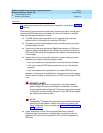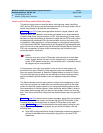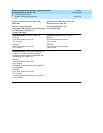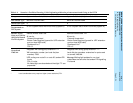
MERLIN LEGEND Communications System Release 6.1
Network Reference
555-661-150
Issue 1
August 1998
Call-Handling Scenarios
Page 2-19Network Configuration Scenarios
2
■ Faster Message Waiting Light Updates. For centralized VMS/AA
systems in Release 6.1 and later, PRI tandem trunks allow Message
Waiting light updates to be sent over the signalling D-channel. With tie
tandem trunks, Message Waiting light updates compete with other voice
and data traffic for available trunks and touch tone receivers. As a result,
Message Waiting light updates may be delayed.
Figure 2–1 on page 2–17
shows some PSTN facilities and PRI tandem trunks in a
hypothetical private network that includes two MERLIN LEGEND
Communications Systems sharing a centralized VMS/AA. A few extensions are
shown so that the scenario can demonstrate how calls are handled and how they
display at different types of extension equipment. Sample PSTN facilities are
shown to illustrate routing when non-local callers use them or when outside calls
are transferred or routed across the private network.
Note the following general facts about this small private network:
■ Both systems share a centralized VMS/AA located on System B. This
might be, for example, a MERLIN LEGEND Mail application.
■ When a caller leaves a message or when a non-local subscriber retrieves
all messages, the centralized VMS/AA sends the Message Waiting light
updates over the PRI D-channel. If all available PRI tandem facilities are
out of service when Message Waiting light updates are attempted, the
updates are queued behind any other earlier queued updates and are
retained on the central system until a PRI facility is returned to service.
Message waiting light updates cannot be sent through the PSTN.
■ The two systems are located in different area codes in the same large
Mid-Atlantic metropolis. They are not, however, geographically distant or in
different time zones. For the purposes of this example, it is assumed that
both systems activate Night Service mode at the same time and night
service calls are routed to the centralized VMS/AA on System B.
■ ARS can be used to route calls over tandem trunks to another system and
then out to the PSTN trunks connected to that other system. For example,
if a user on System A needs to reach an outside party in the 732 (Holmdel,
NJ) area code, the call goes over tandem PRI facilities and then to the
PSTN through an outside facility connected to System B; if a user on
System B needs to reach an outside party in the 212 (New York, NY) area
code, the call goes over tandem PRI facilities and then to the PSTN
through an outside facility connected to System A. When the preferred
routes are used, toll savings are optimal.
■ Coverage for extensions or calling groups on remote systems can be
accomplished by sending overflow or coverage to an integrated VMI calling
group consisting of a single non-local extension referred to as the “VMI
conversion number.” The call is sent over the PRI tandem trunks to the
centralized VMS/AA and includes call information signals that indicate
whether the call originated as an inside or outside call. When the caller
leaves a voice mail message, the centralized VMS/AA sends the Message
Waiting light update over the signalling D-channel to the extension at the
remote system.


















